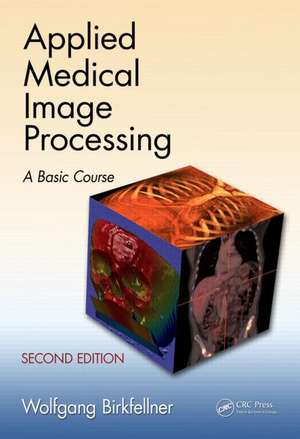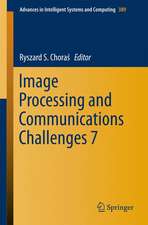Applied Medical Image Processing: A Basic Course
Autor Wolfgang Birkfellneren Limba Engleză Hardback – 6 mar 2014
This Second Edition of the bestseller:
- Contains two brand-new chapters on clinical applications and image-guided therapy
- Devotes more attention to the subject of color space
- Includes additional examples from radiology, internal medicine, surgery, and radiation therapy
- Incorporates freely available programs in the public domain (e.g., GIMP, 3DSlicer, and ImageJ) when applicable
| Toate formatele și edițiile | Preț | Express |
|---|---|---|
| Hardback (2) | 470.22 lei 6-8 săpt. | +47.71 lei 6-12 zile |
| CRC Press – 24 sep 2024 | 553.62 lei 3-5 săpt. | +47.71 lei 6-12 zile |
| CRC Press – 6 mar 2014 | 470.22 lei 6-8 săpt. |
Preț: 470.22 lei
Preț vechi: 559.77 lei
-16% Nou
Puncte Express: 705
Preț estimativ în valută:
89.98€ • 96.22$ • 75.02£
89.98€ • 96.22$ • 75.02£
Carte tipărită la comandă
Livrare economică 18 aprilie-02 mai
Preluare comenzi: 021 569.72.76
Specificații
ISBN-13: 9781466555570
ISBN-10: 1466555572
Pagini: 455
Ilustrații: 293 black & white illustrations, 9 black & white tables
Dimensiuni: 178 x 254 x 25 mm
Greutate: 1.13 kg
Ediția:Revizuită
Editura: CRC Press
Colecția CRC Press
ISBN-10: 1466555572
Pagini: 455
Ilustrații: 293 black & white illustrations, 9 black & white tables
Dimensiuni: 178 x 254 x 25 mm
Greutate: 1.13 kg
Ediția:Revizuită
Editura: CRC Press
Colecția CRC Press
Public țintă
Academic and Professional Practice & DevelopmentCuprins
A Few Basics of Medical Image Sources. Image Processing in Clinical Practice. Image Representation. Operations in Intensity Space. Filtering and Transformations. Segmentation. Spatial Transforms. Rendering and Surface Models. Registration. CT Reconstruction. A Tutorial on Image Guided Therapy. A Selection of MATLAB Commands.
Notă biografică
Wolfgang Birkfellner studied theoretical physics at, and holds a Ph.D in medical physics from, the University of Vienna, Austria. Currently, he is heading the Digital Image Processing Laboratory at the Center for Biomedical Engineering and Physics at the Medical University of Vienna. He is also a reviewer and editorial board member for major journals in the field, program committee member for international conferences, and principal investigator for several third-party funded research projects. Previously, he served as senior researcher at the University Hospital Basel/Switzerland and associate professor of medical physics at the Center for Biomedical Engineering and Physics of Vienna Medical School.
Recenzii
"… very well constructed and extremely useful within its stated scope. The completeness of the treatment of topics, combined with the MATLAB examples of individual functions, is impressive. Examples are explained in great detail, with the command-line code presented, and explained, piece by piece. A student, or anyone else needing to develop image processing functions, will find this book very functional and valuable, both as a textbook and a self-contained reference."
—Computing in Science & Engineering, July/August 2015
"The book is practical and accessible and has limited formalism. I do not know of any other books with this approach for medical image processing."
—Professor Amir A. Amini, University of Louisville, Kentucky, USA
"… a very useful book in an area that needs ongoing information transfer."
—Professor Robert L. Galloway, Vanderbilt University, Nashville, Tennessee, USA
"I mention the book every time I meet someone who asks what the best way is to get into this field."
—Professor Leo Joskowicz, Head of Computer-Assisted Surgery and Medical Image Processing Laboratory, The Hebrew University of Jerusalem, Israel
"The strengths of the book are undulated — it is an exceptionally useful, practical, and approachable tool for teaching medical image computing to undergraduate students."
—Professor Gabor Fichtinger, Queen’s University, Kingston, Ontario, Canada
Praise for the First Edition:
"The topics covered are clearly explained, including explanations of the mathematical operations that are required, therefore making it an ideal text for anyone who is new to medical image processing. … an interesting and helpful introduction to medical image processing. … This text is likely to be of interest to students starting work in medical image processing and would be a useful library text for hospital departments offering training in medical imaging."
—Sarah Cade, Scope, December 2011
"The book … achieves its purpose very well. … The CD adds substantial value to the text and serves as an excellent guide to practice the information covered in the text. … Several books on image processing have been published recently, and this book takes a backseat to none of them. … Students who take a course where this book is used as the course text will be fortunate indeed."
—William Hendee, Medical Physics, Vol. 37, December 2010
"… an outstanding work that will be of interest to virtually all biomedical engineers. The text is easy to follow, supposing only that the reader has a modest knowledge of linear algebra, basic engineering principles, and computer programming. I was impressed by the content as well as by the amount of information that is packed on each page. In each well-organized chapter, important concepts and definitions are described concisely and well. Relevant medical images used for processing complement many of the concepts discussed. Where important, the mathematical formulation is provided. The text and images refer to several MATLAB-based programming examples that are provided at the end of each chapter. These are useful to apply the concepts to actual medical image processing. The book can be used in part as an excellent reference work for biomedical engineers, scientists, and clinicians. This is a well-written, coherent, and comprehensive work covering the major topics in the field, suitable as a standalone text … . The book is enjoyable to read, and students and professionals will not be bored when doing so. Engineers and scientists will find useful coverage of the field, and students will find the entire volume to be filled with important information."
—Edward J. Ciaccio, Columbia University, New York, USA, BioMedical Engineering OnLine, 2011
"I have found this book very useful … . It is comprehensive and well written."
—Professor Terry Peters, Robarts Research Institute, University of Western Ontario, London, Ontario, Canada
"This is a lucid, well-written, and hands-on textbook that explains in simple terms and with examples the basic issues of medical image processing. It contains many examples and useful programs."
—Professor Leo Joskowicz, Head of Computer-Assisted Surgery and Medical Image Processing Laboratory, The Hebrew University of Jerusalem, Israel
"The plethora of examples in each chapter … allows the reader to apply the theory and visually assess the outcomes. This book is a perfect blend of theory and practice. I highly recommend it."
—Dr. Pascal Fallavollita, Technical University of Munich, Germany
"… significant and timely. It provides a cogent, not overly simplified, not excessively mathematical treatise of basic principles that the student, trainee, young scientist, and junior practitioner can readily grasp and apply. … will help facilitate the ongoing, almost magical evolution of modem medical imaging … they who read this book will be able to make 'a truly useful picture'."
—From the Foreword by Richard A. Robb, Ph.D, Mayo Medical School, Rochester, Minnesota, USA
—Computing in Science & Engineering, July/August 2015
"The book is practical and accessible and has limited formalism. I do not know of any other books with this approach for medical image processing."
—Professor Amir A. Amini, University of Louisville, Kentucky, USA
"… a very useful book in an area that needs ongoing information transfer."
—Professor Robert L. Galloway, Vanderbilt University, Nashville, Tennessee, USA
"I mention the book every time I meet someone who asks what the best way is to get into this field."
—Professor Leo Joskowicz, Head of Computer-Assisted Surgery and Medical Image Processing Laboratory, The Hebrew University of Jerusalem, Israel
"The strengths of the book are undulated — it is an exceptionally useful, practical, and approachable tool for teaching medical image computing to undergraduate students."
—Professor Gabor Fichtinger, Queen’s University, Kingston, Ontario, Canada
Praise for the First Edition:
"The topics covered are clearly explained, including explanations of the mathematical operations that are required, therefore making it an ideal text for anyone who is new to medical image processing. … an interesting and helpful introduction to medical image processing. … This text is likely to be of interest to students starting work in medical image processing and would be a useful library text for hospital departments offering training in medical imaging."
—Sarah Cade, Scope, December 2011
"The book … achieves its purpose very well. … The CD adds substantial value to the text and serves as an excellent guide to practice the information covered in the text. … Several books on image processing have been published recently, and this book takes a backseat to none of them. … Students who take a course where this book is used as the course text will be fortunate indeed."
—William Hendee, Medical Physics, Vol. 37, December 2010
"… an outstanding work that will be of interest to virtually all biomedical engineers. The text is easy to follow, supposing only that the reader has a modest knowledge of linear algebra, basic engineering principles, and computer programming. I was impressed by the content as well as by the amount of information that is packed on each page. In each well-organized chapter, important concepts and definitions are described concisely and well. Relevant medical images used for processing complement many of the concepts discussed. Where important, the mathematical formulation is provided. The text and images refer to several MATLAB-based programming examples that are provided at the end of each chapter. These are useful to apply the concepts to actual medical image processing. The book can be used in part as an excellent reference work for biomedical engineers, scientists, and clinicians. This is a well-written, coherent, and comprehensive work covering the major topics in the field, suitable as a standalone text … . The book is enjoyable to read, and students and professionals will not be bored when doing so. Engineers and scientists will find useful coverage of the field, and students will find the entire volume to be filled with important information."
—Edward J. Ciaccio, Columbia University, New York, USA, BioMedical Engineering OnLine, 2011
"I have found this book very useful … . It is comprehensive and well written."
—Professor Terry Peters, Robarts Research Institute, University of Western Ontario, London, Ontario, Canada
"This is a lucid, well-written, and hands-on textbook that explains in simple terms and with examples the basic issues of medical image processing. It contains many examples and useful programs."
—Professor Leo Joskowicz, Head of Computer-Assisted Surgery and Medical Image Processing Laboratory, The Hebrew University of Jerusalem, Israel
"The plethora of examples in each chapter … allows the reader to apply the theory and visually assess the outcomes. This book is a perfect blend of theory and practice. I highly recommend it."
—Dr. Pascal Fallavollita, Technical University of Munich, Germany
"… significant and timely. It provides a cogent, not overly simplified, not excessively mathematical treatise of basic principles that the student, trainee, young scientist, and junior practitioner can readily grasp and apply. … will help facilitate the ongoing, almost magical evolution of modem medical imaging … they who read this book will be able to make 'a truly useful picture'."
—From the Foreword by Richard A. Robb, Ph.D, Mayo Medical School, Rochester, Minnesota, USA
Descriere
Avoiding excessive mathematical formalisms, this second edition of a bestseller delivers an ideal introduction to medical image processing, presenting key principles and algorithms using simple MATLAB®/Octave scripts. It not only discusses data storage, transformations, segmentation, rendering, registration, and reconstruction, but also contains a chapter on clinical applications and an image-guided therapy tutorial. Including examples from radiology, internal medicine, surgery, and radiation therapy, the text is beneficial to students of medical physics, biomedical engineering, computer science, applied mathematics, and related fields, as well as radiology professionals.















